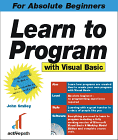Learn to Program with Visual Basic 6

|
|
This book presents itself as an account of a college course, taught by Smiley, in which the students developed a program that allows the customers of a china shop to get price quotes on different table settings. As they work toward delivering the program to the merchant, Smiley's students learn all about figuring out product requirements, designing software, and the many technical details that define Windows programming in general. After quite a bit of planning, Smiley details the mechanics of writing code in Visual Basic 6 (a limited copy of which appears on the book's companion CD-ROM), which eventually enables his students to deliver a working program to the shopkeeper.
Smiley's classroom-style presentation--complete with Aristotelian dialog--means you need to read this book from cover to cover and work through the procedures sequentially at least once. After that, you'll be ready to experiment independently and read more specialized Visual Basic books. --David Wall
Customer Reviews:
Excellent for beginners, July 27, 2000
Reviewer:bubelah from Bruxelles Belgium
I had to learn VB for my current job and did not know anything about programming.For the first page on, I felt my knowledge was increasing and so did my self-confidence. John Smiley starts his book with a general introduction about how computers process information and with a review of the basics (like the concept of variables, how to use them and where, and why!; the basic VB controls, etc). Then through the project implemented throughout the book you get a picture of how all these elements combine in order to develop an application. This book is really for beginners, you don't need previous knowledge to fully enjoy it. John Smiley's style is very friendly and not obscure at all, it is often enriched with real life examples. I would say it is a must. If you have to start somewhere, this is it! I have now read "Learn To Program Databases with VB 6" by Smiley as well and it is the logical follow-up of his previous books (I personnaly skipped the book on Vb examples but I consider buying it). To do professional work I think it is necessary to go into further details. Smiley's books provide you with the required foundations.
Learn to
Program with John Smiley, April 3, 2000
Reviewer:
Scott M. Dexter from
Pulaski, New York
This is a great
book for the beginer. I have some VBA experience and this book should be
enjoyable enough for everyone. It does not ramp you right into programing
though. What it does do instead is take you step by step through the
process that a real programmer goes through in the development and writing
of an actual real world program for a real company. No "Hello World" here.
If your are antsy then go buy something else. If you are serious then be
patient and Master every aspect of the book one step at a time and know
what you are doing with the in-depth explanations that precede and follow
your work. I used this book as an intro to ramp myself up for the
Mastering Microsoft Visual Basic Fundamentals, a Microsoft certified
curiculum class and I found myself far above and beyond the understanding
level of the others in my class. They were missing pieces of information
that were necessary in their development as a programmer. I rate this 5
stars and have since purchased the examples book as well as the database
book. Thanks John I look forward to all of the books that you will
write.
Excellent for the
begginer, February 20, 2001
Reviewer: Donald E Fuller from
Beaverton, Oregon United
States
I bought this book
because of all the excellent reviews I had read. I was not disappointed! I
went from knowing nothing about VB to creating a test tool used in our QA
department within a few months.
I am someone who learns best by examples and this book is filled with examples. If you are someone who works best with pages of code with limited explanations this book is not for you. I will admit that the examples got a bit tedious after a while but I will not lower the ranking of the book because of that.
If you are using this book as an intro to VB programming it is an excellent book to own. If you are using this book as a basis to create your own programs (as I did) you will want to get a more in-depth VB programming book to go along with it. This book covers a lot of topics but leaves many out (how to turn your code into an .EXE or how to include a Help file for example) I found a second more in-depth book to fill in the holes very helpful.
The above aside, if you are want to learn VB and
want the best introductory book on the market look no further.
Beginners ONLY!,
February 9, 2001
Reviewer: A reader from NY
This book is for a person who has never wrote a visual
program or used any visual compiler. If you can write a visual program as
simple as "hello world" then you might want a more complete book. This
book is by far complete. There are many of the visual tools that are not
explained. A better book for a beginner would be (visual basic from the
ground up).
Back to Books